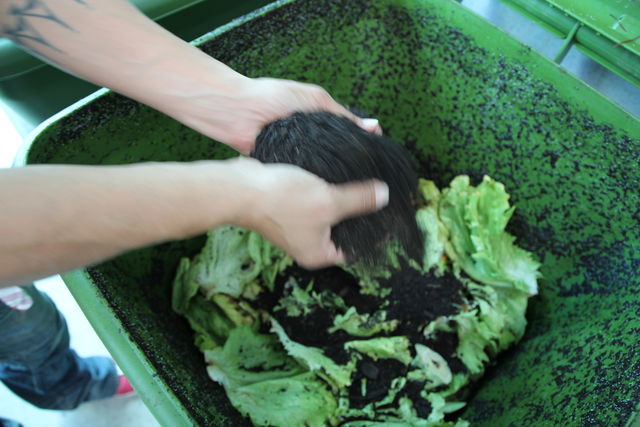Where do I get the worms?
The best place to purchase worms for your hungry bin is from the hungry bin website.
http://www.hungrybin.co.nz/buy/
Our worms are of the highest quality and are supplied ready to be placed into your bin. Worms are harvested to order, so they will arrive in the best condition possible. Although the worms have a shelf life of up to two weeks, we recommend installing them into your bin immediately.
Harvest your own worms
You can start the hungry bin with compost worms dug out of existing worm farms, compost heaps or harvested from the natural environment. Wild compost worms can live in lawns, fields and under trees and you may be able to harvest some to start your bin. A good way to attract compost worms is to make a thin layer of food scraps on the ground in a suitable location and cover it with sackcloth. Add fresh food scraps every week. After a few weeks you will notice worms beginning to appear – these can be harvested and placed in your hungry bin. Compost worms are fast breeders. Under ideal conditions they will double their numbers every three months.
What are compost worms?
Compost worms are different from common garden worms that live in soil.
Unlike earthworms, compost worms do not make burrows in the soil, but live in the surface layer (the top 30cm or 12in). They have evolved to eat rotting plant matter on the forest floor, and are perfectly suited to break down organic waste. Compost worms are generally smaller than earthworms.
Tiger worms (Eisenia foetida), Red worms (Lumbricus rubellus) and Indian blue worms (Perionyx excavatus) are the most common worms used for composting.
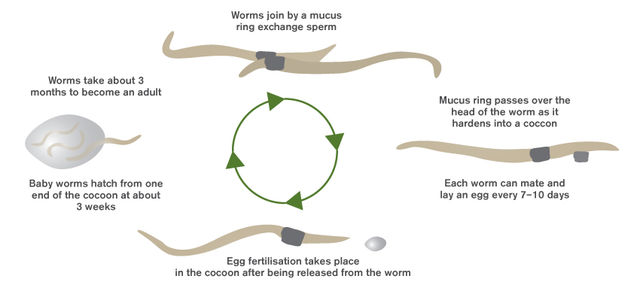
Help, my bin's starting to smell ...
If your hungry bin is starting to smell, or the food is rotting before the worms can eat it, add a fine layer of fibrous brown material each time you feed the worms to help balance the bin. You can also sprinkle a fine layer of soil or potting mix into the bin to help balance it. A diet of food scraps can be too rich for the worms unless the scraps already contain plenty of fibre (lots of vegetable stalks for example), in which case you won’t have to add as much to keep your worms healthy and your bin smelling sweet.
The food in the hungry bin needs to have the right ratio of carbon to nitrogen for the bin to be most effective. The ideal carbon to nitrogen ratio for a worm farm is 20:1, however, food scraps can often have a ratio of 12:1. To balance the ratio of carbon to nitrogen, some extra material high in carbon may need to be added to the bin.
Fibrous materials are carbon rich, which also help balance the higher level of nitrogen in food scraps. Also referred to as bulk or roughage – fibre doesn’t tend to break down and rot as quickly as food scraps. It includes paper or cardboard, dead leaves, sawdust or wood shavings, vegetable stalks, old grass clippings (brown).
The bin may also develop an unpleasant smell if it has become too acidic. Sprinkle a small amount of dolomite lime or rock dust on the top layer to help reduce the acidity of the bin. Adding fibre to the food when you are putting it in the bin may also help reduce problems with acidity.
Should I add water?
Generally you should not need to add water to the hungry bin. Food scraps have a high water content, which helps keep the bin moist. The design lets excess water drain from the bin, but ensures enough moisture is retained to maintain optimal conditions. The worms do need to be moist though, so if the bin has dried out, sprinkle a little water on the top of the bin. If you have added dry matter like shredded paper you may also need to add water. Take care not to drown the worms, the top should only be as wet as a wrung-out sponge.
How much liquid should my bin produce?
The bin will produce about half a litre (one pint) of liquid a day when it has a full worm population and is fed regularly. It is important that the liquid is free to drain from the bin at all times.
If liquid from your bin is not collecting in the drip tray, it may be too dry. See Should I add water? above. The filter tray may also have become blocked with paper or plastic if this has been placed in the bin. Remove the floor and check the filter.
Check that the bin is not exposed to intense sun for long periods and move to a shadier spot if necessary.
The liquid fertiliser should be mixed 1 part with 10 parts water before being sprinkled onto the soil around plants.
Juice is evaporating?
If you are not getting much liquid it may be evaporating before you get a chance to use it. In this case you can place a suitable jug or bottle under the floor to catch the juice. Placing a funnel in the neck of a bottle will help catch the juice.

No Juice?
If you have started you hungry bin with commercial compost mix or potting mix, it can take a while for the compost to become fully saturated, and the liquid to start running from the hungry bin. You can help the process along by sprinkling a little water from a watering can slowly over a couple of days until there is juice draining from the hungry bin.
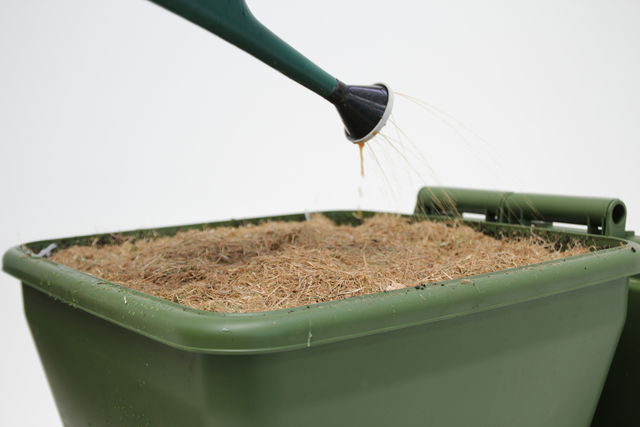
My worms are trying to escape …
Sometimes worms will cluster at the top of the bin, and on the underside of the lid, if it is about to rain. This is a natural response to prevent them from drowning in the wild, or to migrate to fresh food when the ground is wet. They will return down into the surface layer when the rain has passed.
If the conditions in the bin are unfavourable the worms will also try to migrate. This is usually caused by overfeeding, or if the food has become too acidic. However, if you keep the lid on as recommended, it is almost impossible for them to escape. Occasionally a worm may fall from the bin into the drip tray, especially if castings have recently been removed.
If the food is too wet the worms will look fat and pale. Add some dry leaves or shredded paper. Gently use a fork to turn the top layer and create some drain holes on the surface.
If heavy rain is flooding your bin try moving it to a more sheltered location.
Going on holiday?
The hungry bin can be left for two to four weeks without fresh food. Adding shredded paper, dead leaves or dry lawn clippings to the food for a week or two before you go away helps the food last longer. Water any dry material you add to your hungry bin to ensure the bin doesn't dry out while you are away.
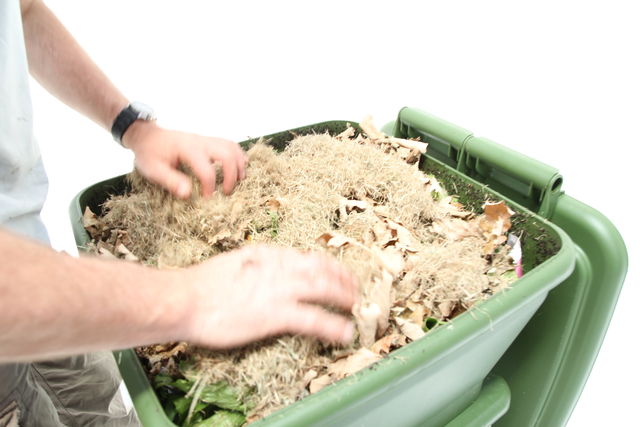
If you are going away for a month or two, it’s no problem either. All you need to do is alternate layers of leaves, dried grass clippings, shredded paper with alternate layers of food scraps. A total of 30 cm will last for a couple of months without too many problems. If you are away for longer, you may need to ask a freind to feed your farm while you are away.

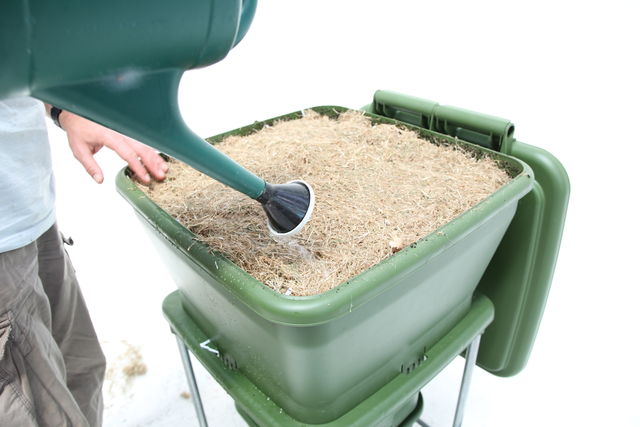
Flies, ants and other insects
The hungry bin is designed to prevent pests from entering. However, it is a living ecosystem and some small beneficial insects can exist in the bin quite happily. Sometimes these other insects are eating food the worms don't like or prefer not to eat. Insects may also be present in food scraps that are introduced to the bin, e.g. fruit fly larvae.
The food in the bin will naturally attract other creatures. Sometimes insects like white fly are attracted to the bin because the food is too acidic. Try balancing the food with a little lime, shredded paper, dead leaves or sawdust. Covering the food with a hessian sack, old carpet or damp newspaper will also discourage unwelcome visitors.
Ants
If the farm is too dry, ants can also establish their nests in the hungry bin itself. Keeping the surface moist will help discourage ants. Ants can be discouraged from enetering the bin by ensuring the bin is not touching a surface the ants can enter the bin from, and then smearing a layer of petroleum jelly on the legs just under the sockets on the lower body.
Fruit flies
Fruit flies are attracted to rotting fruit or sweet smelling scraps in the bin. Fruit flies will normally be present in the bin, but if you have large numbers it can be unpleasant and indicate that the balance in the hungry bin has changed.
Try burying your food scraps under the top layer. In addition, you can place a couple of layers of damp newspaper flat over the surface. Each of these helps to keep adult fruit flies from accessing the buried food, where they lay their eggs.
Maggots
Maggots are the larvae of flies. There are many different kinds. The type you may see in your bin will depend on what you are feeding your worms, where you live and the time of year. While many people find maggots unpleasant, they will not harm you or your worms. In fact, they are good decomposers and, like the compost worms, will produce a high-quality casting.
If you haven't added animal proteins, and don't have any foul odours in the bin, then it is likely the maggots you are seeing will be black soldier fly larvae. Once your bin has black soldier flies present, it can be difficult to get rid of them. It may be best to simply allow them to grow out of the larval stage (which they do quickly) and fly off. If you have large numbers present, harvest the worms and get rid of all your affected castings (put them in an outdoor compost pile, or bury them in the garden). Then put your worms back into fresh bedding.
Slaters
Also known as pill bugs, sow bugs and woodlice. They are beneficial bugs in your bin helping to break down all the compostable material. If you wish to remove them, you could lay damp newspaper on top of the food scraps overnight, in the morning remove the paper with the slaters attached. If you have chickens, you could feed them the slaters. Slaters can also be an indication that the bin is dry so add some water to reduce their population.
Red spider mites
Red spider mites are very common in worm bins. They are usually present when there is a source of bread and protein. These mites can be a problem if you find your worm population depleting. You can remove them by putting in food overnight that the mites are attracted to (like watermelon rind) then remove the next morning with the mites attached and wash them off. Repeat the process until you are satisfied with the result.
Black soldier fly
See Maggots above.
Earwigs
Also known as pincher bugs, these are harmless creatures in the worm bin. They generally indicate a slightly acidic environment, which can be remedied easily by adding a handful of garden lime.
White worms
Also known as pot worms or grindle worms. They will not harm your worms but can be an indication that the bedding is too acidic. Add a handful of dolomite lime or garden lime.
Centipedes/Millipedes
These little arthropods feed on composting material but are also known to feed on small insects including the odd worm. Best to evict these visitors as you see them. Watch out for their pincers!
Cockroaches
These omnivores are attracted to food scraps. Avoid putting in any meat products. They also like dark tight crevices so you could uncover the bin for periods of time, which will make the worms work at lower levels and discourage the cockroaches from taking up residence. However, keeping the lid on in the first place will prevent them entering. To get rid of cockroaches without using baits you could try a 1:1 mixture of baking soda and sugar. Spread it around the outside of the bin.
Fruit flies?
The food scraps you have placed in to your hungry bin are very attractive to a host of other critters, not just worms. Normally this is not a problem, but in the warmer months, fruit flies can be an issue. This is especially true if you are eating a lot of fruit like kiwi fruit or bananas which have high sugar levels.
The best way to reduce the fruit flies present in your hungry bin is to ensure that you are adding enough fibre to balance the acidity, and to cover the food with a layer of newspaper or leaves each time you feed your hungry bin. Sprinkling some dolomite lime on the top of the food will also help reduce the acidity that is attracting the fruit flies.
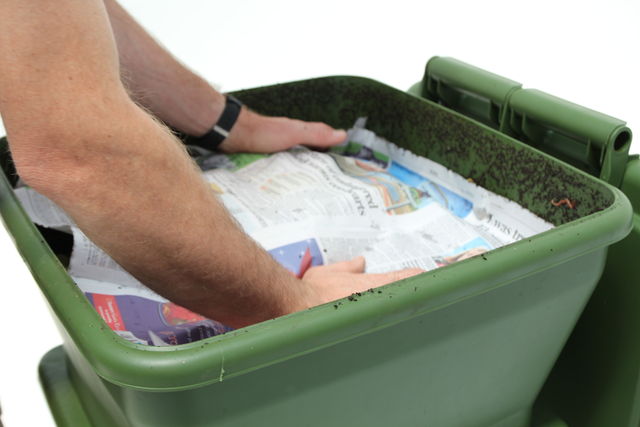
The level in the bin has dropped
If the level in your hungry bin has dropped, don't worry. it's an easy problem to solve. Just add some soil or finished compost each time you feed the hungry bin.
